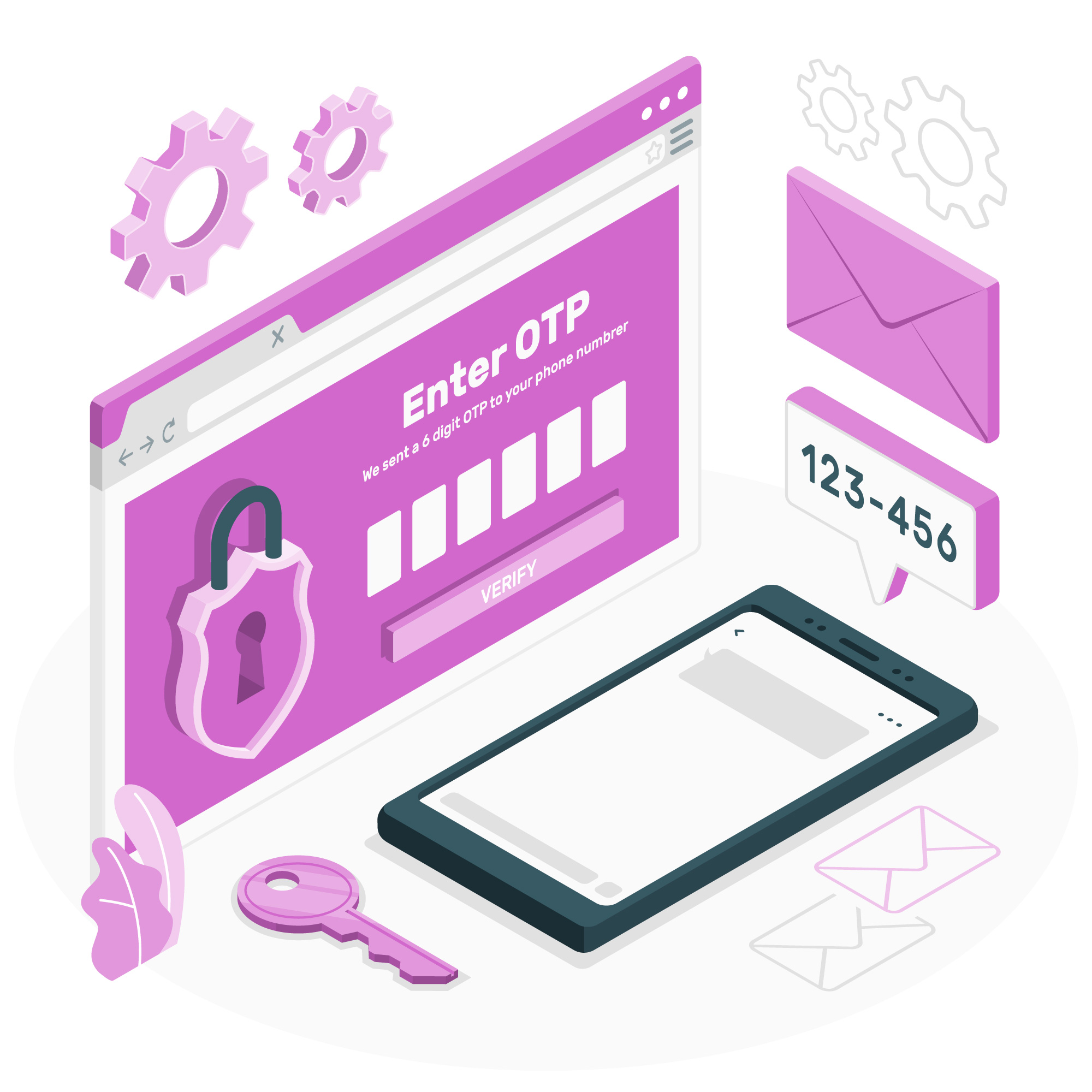Implementing OTP APIs in modern applications enhances security by verifying user identities through time-sensitive codes. Securing user data and ensuring safe transactions are necessary in the digital space.
One of the most effective ways to support security is by implementing One-Time Password (OTP) authentication. This article will explore implementing OTP APIs into modern applications, providing developers with the necessary knowledge and steps to enhance their applications’ security features.
What is OTP authentication?
OTP authentication involves generating a unique password to confirm a user’s identity, valid for only one session or transaction.
Unlike traditional passwords, OTPs are temporary and offer an additional security measure by preventing unauthorized access, even if a user’s password has been compromised.
OTPs are commonly sent via SMS, email, or in-app notifications, and users need to enter the OTP to proceed with actions such as logging in, completing a transaction, or accessing sensitive data.
The advantages of OTPs in your application
The importance of implementing OTP APIs in modern applications includes:
- Enhanced security and behavioral change: OTPs significantly reduce poor security habits among users, who often reuse weak passwords or share credentials. By adding a temporary password requirement, OTPs protect against the risk of compromised passwords.
- User verification: OTPs provide a straightforward way to confirm a user’s identity. By requiring a unique code for account access or transaction completion, businesses ensure that only the rightful user can proceed.
- Multiple delivery options: OTPs can be sent to users through various channels, including SMS, email, or in-app notifications. This flexibility makes them accessible and user-friendly, catering to different preferences.
- Fraud prevention and IT efficiency: OTPs prevent fraudulent activities by verifying user identity before granting access. They also free IT administrators from the burdens of password management. Traditionally, IT teams invest significant time designing password policies and managing security best practices.
Choosing an OTP APIs provider in modern applications
When deciding on an OTP API provider, it’s important to evaluate options based on a few critical factors:
- Reliability: Look for a provider with a history of strong uptime performance. If users experience OTP delivery delays, this can negatively impact user experience and trust.
- Scalability: Choose a provider that can handle increasing user activity without issues. As your user base grows, so will the demands on the OTP system.
- Security features: A good OTP API provider should offer strong security measures, such as encryption and secure data handling, to protect user and transaction information.
- Documentation quality: Clear and thorough documentation makes integration accessible and reduces the chance of errors.
- Pricing structure: Compare costs based on your projected usage. Some providers charge per OTP sent; others offer monthly subscriptions or bulk discounts.
A step-by-step approach to implementing OTP APIs
Integrating an OTP (One-Time Password) API into your application involves steps to ensure a secure and smooth user experience.
By combining practical implementation with understanding how OTPs work, you can create a secure and user-friendly authentication system. This approach enhances your application’s security and boosts user trust and satisfaction, ensuring your OTP solution is effective.
Step 1: Understand the user flow and requirements
- User actions: Identify when users need OTPs (e.g., during login, account creation, or sensitive actions).
- OTP type selection: Based on your security needs and user convenience, decide which type of OTP to use (TOTP, HOTP, or transmission-based).
Step 2: Set up your development environment
To start, ensure you have:
- A backend server, such as Node.js, Python (Flask/Django), or Ruby on Rails.
- Ensure you have an account with an OTP API provider, including API credentials.
- A front-end application where users can interact with the OTP features.
Step 3: Install the required libraries
Install any libraries necessary for making API calls based on your chosen programming language or framework. Libraries such as axios for JavaScript or requests for Python can simplify API interactions.
Step 4: Configure the OTP APIs
Create a configuration file to store your OTP API credentials securely. It will allow your application to connect with the OTP provider whenever needed.
Step 5: Implement OTP generation
Create a function that generates an OTP and sends it to the user’s preferred contact method. This function will request the OTP API to generate and send the code.
Step 6: Store the OTP securely
Store the OTP temporarily for verification purposes. Options include using a database, an in-memory solution, or a caching tool like Redis. Ensure that storage is secure to prevent unauthorized access.
Step 7: Implement OTP verification
Once the user submits the OTP, verify it against the stored OTP. If the OTPs match, grant the user access to the requested resource.
Step 8: Create API endpoints
With the OTP generation and verification functions ready, set up endpoints in your backend for sending and verifying OTPs.
Step 9: Design frontend integration
Design a user interface in your front-end application where users can request an OTP and enter it for verification. It could be a simple form on a web application or an interface on a mobile app.
Step 10: Testing and quality assurance
Testing is a crucial part of OTP implementation. Here is how to ensure everything works as expected:
- Unit testing: Test individual functions for correct functionality.
- Integration testing: Ensure the entire OTP process works smoothly, from sending to verifying.
- Load testing: Simulate high-traffic scenarios to ensure your system can handle multiple OTP requests without slowing down or crashing.
- Security testing: Confirm that OTPs are securely stored and transmitted to prevent interception or replay attacks.
Step 11: Monitoring and logging
Once deployed, monitor OTP API usage to detect and resolve issues early. Logging will be set up to record OTP requests, verification attempts, and errors, which will help troubleshoot and improve the user experience.
Practical application of theoretical knowledge
The practical application of theoretical knowledge bridges the gap between concepts and real-world execution, empowering individuals to transform abstract ideas into actionable solutions.
Understanding the selected OTP mechanism:
- If you choose a Time-based One-time Password (TOTP), ensure you understand how time synchronization works and how to handle potential issues with time drift.
- For transmission-based OTPs, consider how the user receives OTPs and ensure the delivery method (SMS, email) is reliable.
Incorporating security measures:
- Familiarize yourself with OTP security best practices. For instance, understand the implications of storing OTPs and ensure they are hashed or encrypted.
- Educate users on best practices for handling OTPs, such as not sharing them and recognizing phishing attempts.
Feedback loop for continuous improvement:
- Gather user feedback on the OTP experience (ease of use, delivery time, etc.) and refine your implementation based on this feedback.
- Stay updated on OTP technology advancements and incorporate new features or standards as they become available.
Popular OTP APIs providers to implement
Several established providers offer OTP API services, each with their strengths. Here are a few:
- Arkesel: Arkesel is known for its security services, including OTP, Bulk SMS, Voice, Email, and USSD solutions. It offers a reliable option for businesses looking to secure their applications.
- Twilio: Known for a wide range of communication APIs, Twilio provides SMS, email, and in-app OTP solutions that integrate with most major programming languages and frameworks.
- Nexmo (Vonage): This platform offers versatile OTP solutions, including SMS and voice-based verification.
- Firebase authentication: Part of the Google suite, Firebase Authentication offers OTP and multi-factor authentication features, ideal for applications with a global user base.
Security tips for using OTPs effectively
Implementing OTP APIs strengthens your application’s security; follow these best practices below to maximize the benefit:
- Use short expiration times: Set OTP expiration times to limit the chance of interception. OTPs that expire within a minute or two provide more security.
- Avoid reuse: Each OTP should be unique to prevent attackers from guessing or reusing them.
- Implement rate limiting: To prevent force attacks, limit the number of OTP requests or verification attempts.
- Provide clear user feedback: Ensure users receive clear instructions for entering their OTPs and give feedback if verification fails.
- Use secure channels for transmission: Ensure OTPs are sent over secure channels to protect against interception.
Making OTPs a stable security measure
Implementing OTP APIs for authentication is crucial for enhancing security and building user trust by protecting sensitive data and reassuring users.
A user-friendly interface for OTP requests can enhance user engagement, resulting in greater satisfaction and loyalty. At the same time, it is important to balance security with user experience.
While you want users to feel secure, reducing their frustration when accessing your app is vital. Well-implemented OTPs provide a safer alternative to static passwords, especially if not sent via SMS, while still being easy for users to handle.
Security is a continuous process, so it is essential to assess and update your OTP system regularly. Listen to user feedback and keep up with security trends to protect against new threats.
Using OTP authentication improves your app’s security and builds user trust while preparing you for future challenges. With the right plan, OTPs can be a part of your security strategy, giving you and your users peace of mind and a smooth experience.





